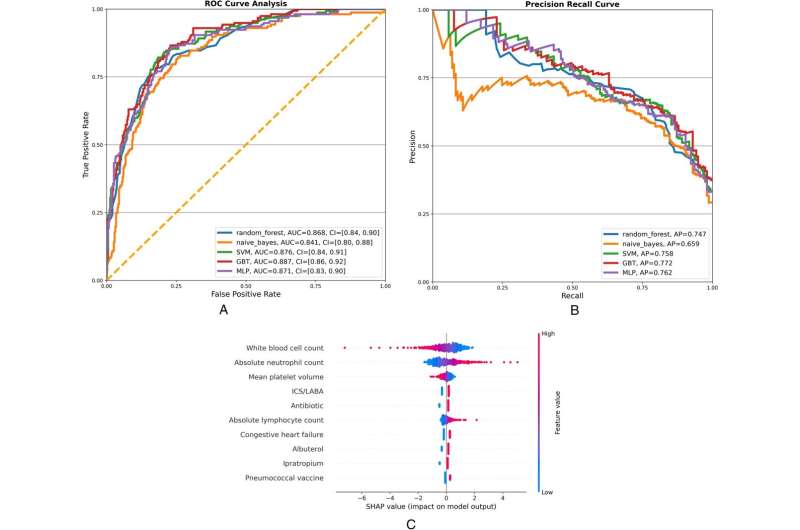This article has been reviewed according to Science X's editorial process and policies. Editors have highlighted the following attributes while ensuring the content's credibility:
fact-checked
peer-reviewed publication
trusted source
proofread
Using AI to identify high risk patients with asthma and COPD

Asthma and chronic obstructive pulmonary disease (COPD) are two of the most common lung diseases worldwide, and exacerbation of these conditions can negatively impact health and increase health care costs. A new study shows that deep learning, a type of artificial intelligence (AI) that uses large amounts of data to process information, can improve detection of patients with these diseases who are at increased risk for multiple hospitalizations.
The study was published Dec. 13, 2023, in the journal Respiratory Research.
In the study, researchers identified electronic health record (EHR) characteristics of severe asthma and COPD exacerbations. They then evaluated four machine learning models and one deep learning model in predicting hospital readmissions using EHR data. The researchers found that multilayer perceptron, a deep learning method, had the best performance.
The findings show that AI can play a role in helping pulmonologists develop new classifications for asthma, COPD, and other conditions, said Jose Gomez-Villalobos, MD, associate professor of medicine and director of the Center for Precision Pulmonary Medicine (P2MED) in the Section of Pulmonary Critical Care and Sleep Medicine (Yale-PCCSM) at Yale School of Medicine.
"The implementation of these methods can help us identify groups of patients who may benefit from specific treatments or who have characteristics that are not always obvious to the clinician," Gomez-Villalobos said. "If we know which patients have increased needs or can benefit from targeted therapies, we can reduce their likelihood of needing to return to the hospital."
Most importantly, the study highlighted significant racial and ethnic disparities in the burden of these disease exacerbations, Gomez-Villalobos noted. "Minority groups are disproportionately affected by these hospitalizations," he said.
The new tools are an important step in ensuring that patients receive the best care possible, said Naftali Kaminski, MD, Boehringer Ingelheim Pharmaceuticals, Inc. Professor of Medicine and chief of Yale-PCCSM. "Incorporating deep learning and AI into clinical practice can help prioritize care for vulnerable individuals with respiratory disease, and I am proud of the groundbreaking progress our P2MED researchers are making towards this goal," he said.
As pulmonologists work to improve the management of asthma and COPD, Gomez-Villalobos envisions applying computational methods and AI to tailor interventions, improving outcomes for patients from minority and other groups who may be at high risk. The new knowledge will decrease events that cause patients to go to the emergency room or hospital—an expensive and intense use of resources, he said.
"The power of these neural networks—or AI—is that they enable us to synergize and transform what we do as clinicians to achieve better outcomes for all patients," he said.
More information: Kevin Lopez et al, Deep learning prediction of hospital readmissions for asthma and COPD, Respiratory Research (2023). DOI: 10.1186/s12931-023-02628-7




















